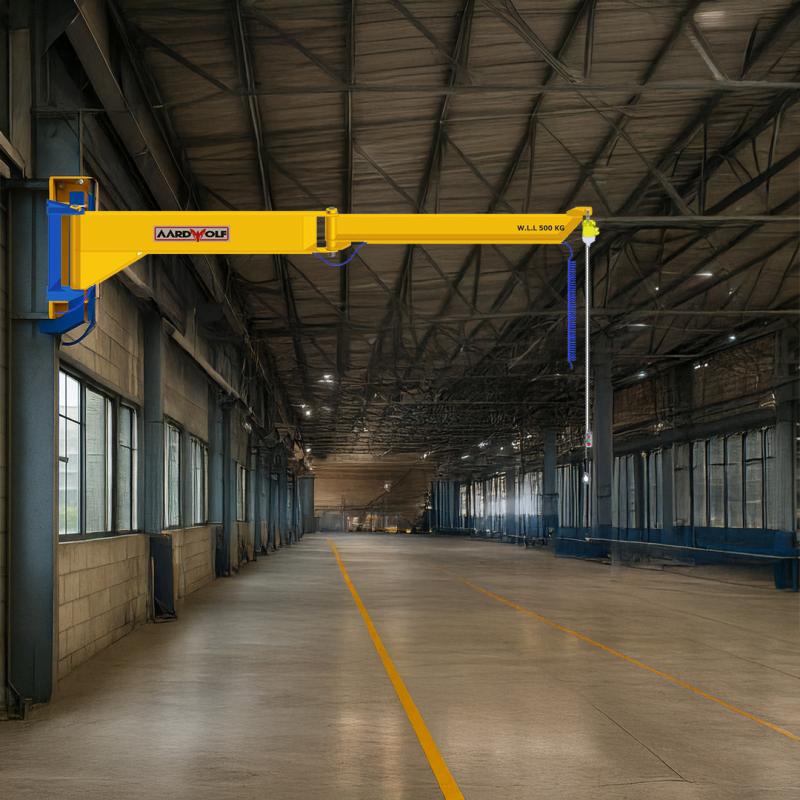



In the world of material handling, a jib crane is an indispensable piece of lifting equipment, offering remarkable versatility, efficiency, and safety in various industries. This guide provides comprehensive insights into jib cranes, detailing their types, uses, and manufacturing processes.
A jib crane is a specific type of crane characterized by its horizontal beam, or "jib," extending from the crane structure. It supports a movable hoist, allowing efficient handling of materials. Ideal for confined workspaces, jib cranes offer lifting capacities ranging from a modest 250 pounds to an impressive 15 tons, accommodating diverse industrial requirements.
Freestanding jib cranes are among the most versatile in material handling environments. They can perform independently or in conjunction with other overhead lifting systems, like gantry cranes or bridge cranes. Their 360° rotation capability significantly expands workspace efficiency, making them suitable for diverse tasks across industrial and warehouse settings.
Base Plate Mounted: Ideal for installations requiring versatility, allowing easy relocation.
Foundation Mounted: Provides maximum stability for heavy-duty lifting.
Sleeve Insert Mounted: Offers flexibility for future facility expansions or modifications.
Wall-mounted jib cranes efficiently utilize vertical space without encroaching on floor space. They’re especially beneficial in tight workspaces like maintenance shops or assembly lines. Commonly available in cantilever and tie rod supported configurations, wall-mounted jib cranes ensure optimized lifting capabilities while maintaining clear operational areas.
Featuring a dual-arm system, articulating jib cranes enable precise handling around obstacles or into tight spaces, enhancing operational flexibility. Commonly employed in intricate assembly lines or compact industrial environments, these cranes ensure ease of maneuverability and accuracy.
Mast jib cranes offer robust support by anchoring to structural beams, providing heavy lifting capacities without extensive foundation modifications. Suitable for rigorous manufacturing and logistics applications, these cranes maximize workspace efficiency.
These cranes offer mobility and convenience, essential for handling materials in multiple locations. Often complemented by other lifting equipment such as scissor lifters, portable jib cranes streamline operations in dynamic environments.
Hydraulic jib cranes utilize powerful hydraulic systems for efficient lifting. They excel in applications requiring adjustable lifting heights and reduced manual effort, commonly seen in automotive repair and small-scale manufacturing.
Ceiling-mounted cranes solve critical space constraints by maximizing overhead space utilization. Suitable for high-density storage and assembly operations, they maintain clear floors while delivering robust lifting capabilities.
Designed specifically for repetitive tasks, workstation jib cranes enhance productivity by simplifying frequent lifting operations. They are essential in assembly lines and repair workshops, promoting ergonomics and efficiency.
Highly mobile, truck-mounted jib cranes are indispensable in construction, maintenance, and emergency services. They facilitate efficient on-site operations, allowing quick deployment and precise load placement in challenging terrains.
Manufacturing a jib crane involves several meticulous stages, ensuring durability and operational excellence:
Key crane components include the mast, boom, hoist, and trolley. Materials such as high-tensile steel ensure structural integrity and longevity. Precision fabrication methods, such as cutting, welding, and machining, guarantee reliable performance under rigorous industrial conditions.
Cranes are assembled by combining fabricated components, including installing hoists (electric, pneumatic, or manual), trolleys for horizontal movement, and rotation mechanisms. Attention to safety features, such as rotation stops and festoon systems for cable management, ensures safe crane operation.
Once assembled, jib cranes undergo stringent testing to verify lifting capacity, structural integrity, and operational safety. Compliance with industry standards and certifications guarantees reliable performance and workplace safety.
Jib cranes significantly enhance manufacturing efficiency by facilitating swift component transfers and assembly operations, reducing manual handling requirements and improving productivity.
In logistics environments, jib cranes complement larger material handling systems, such as gantry cranes, by offering precision lifting and positioning of goods onto transport vehicles.
They are essential for material placement in challenging locations like multi-story buildings or underground structures, substantially improving productivity and safety on construction sites.
Jib cranes optimize loading and unloading operations at docks and shipping terminals, enabling efficient transfer of materials between ships and trucks, complementing robust lifting systems.
Choosing the right jib crane involves considering several factors:
Duty Cycle: Match crane capacity and performance with expected usage frequency.
Workspace Configuration: Consider rotation range, boom height, and spatial constraints.
Load Requirements: Ensure lifting capacity meets operational demands.
Power Source: Determine appropriate electrical or pneumatic power options for crane operation.
Integrating jib cranes with complementary equipment such as ratchet tie-down straps ensures secure material handling during lifting operations. Proper equipment usage enhances operational safety, protecting both personnel and materials.
Jib cranes play a pivotal role in modern material handling, offering unparalleled versatility, efficiency, and safety. Understanding jib crane types, manufacturing processes, and operational applications ensures optimized lifting solutions, fostering improved productivity and safer workplace environments across diverse industries.
Sign up to receive the latest info on new Aardwolf products, special offers and more.
By signing up you agree to receive emails from Aardwolf with news, special offers, promotions and other information. You can unsubscribe at any time.